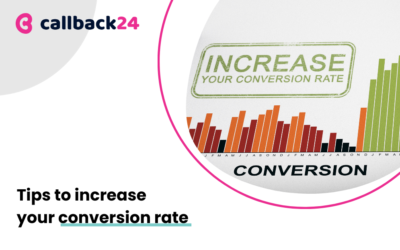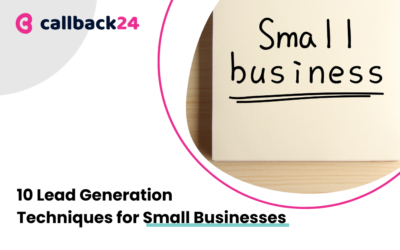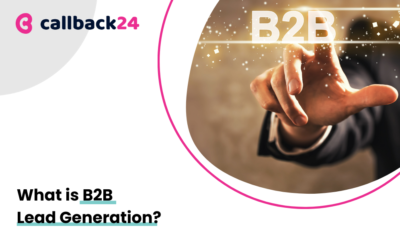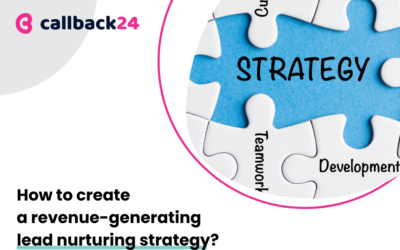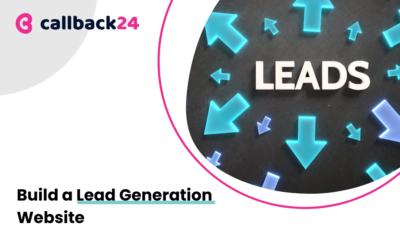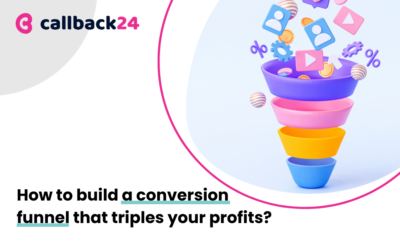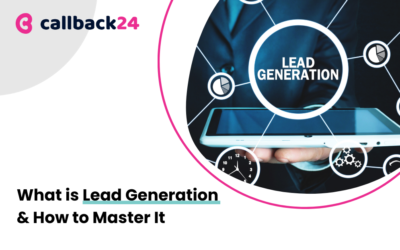TL;DR
- Lead generation is a process of identifying and qualifying potential customers for your product or service. To be successful at lead generation, you need to have a solid understanding of your target market and what they’re looking for. The goal of lead generation is to generate more leads that can be converted into sales.
- The most important lead generation metrics will depend on your sales cycle and what your goals are for lead generation. The most important lead generation KPIs to measure is: Conversion rate, Time on the page, Click-through rate (CTR), Return on Investment (ROI), Lead generated rate, Bounce rate, Cost metrics including cost per lead, cost per sale, customer acquisition costs, Channel metrics includes TOFU, MOFU and BOFU, and Month-to-Date Channel Goals.
- To analyze landing page, you can monitor these lead generation metrics: Traffic-to-lead ratio, Lead value, and lead quality, Attribution of a lead, Customer Lifetime Value
What is lead generation?
Lead generation is a process of identifying and qualifying potential customers for your product or service. It’s the first step in the sales process, and it can be a challenge to generate leads that are both high quality and relevant to your business.
To be successful at lead generation, you need to have a solid understanding of your target market and what they’re looking for. You also need to have a well-defined lead generation strategy that includes both online and offline marketing channels.
Once you’ve generated a list of potential leads, it’s important to qualify them to ensure they’re interested in what you have to offer. This can be done through lead scoring, which assigns a numeric value to each lead based on factors like demographics, interests, and engagement level.
What is the goal of lead generation?
The goal of lead generation is to generate more leads that can be converted into sales. There is some lead generation KPIs that you can track to measure your success, including lead conversion rate, cost per lead, and lifetime value of a customer.
By understanding the lead generation and using the right lead generation KPI to track your progress, you can increase the number of high-quality leads for your business and close more sales.
How can I identify the important lead generation metrics?
There are several lead generation metrics that you can track, but not all of them will be equally important for your business. The most important lead generation metrics will depend on your sales cycle and what your goals are for lead generation.
What are the common lead generation metrics?
Some common lead generation metrics include:
- Number of leads generated
- Cost per lead
- Lead conversion rate
- Sales cycle length
- Customer lifetime value
To determine which lead generation metric is most important for your business, start by evaluating your sales cycle and identifying where leads typically fall off. This will help you to identify any areas that need improvement. Once you have pinpointed the key areas of improvement, you can then focus on tracking the relevant metrics.
For example, if you find that a large number of leads are being generated but few of them are converting into customers, then your lead conversion rate will be the most important metric to track. On the other hand, if you have a lengthy sales cycle, then tracking the length of the sales cycle will be more important.
No matter which lead generation metric you choose to focus on, it’s important to track it over time so that you can see whether or not your efforts are having a positive impact. By regularly evaluating your lead generation metrics, you can make sure that you’re on track to achieving your goals.
What lead generation KPIs are good to measure?
Conversion rate
Conversion rate is one of the most important lead generation KPIs. It shows you how successful your lead generation efforts are in terms of generating qualified leads for your sales team. A high conversion rate means that your lead generation campaigns are effective and are resulting in more sales. A low conversion rate indicates that your lead generation campaigns need improvement.
Time on page
It’s true that the content has power. Content marketing has become largely an industry staple today, so you shouldn’t surprise yourself by revealing how content helps you drive more leads for your company. Another important lead generation KPI is time on page. The amount of time spent on the website is highly correlated to good lead quality. Conversely, if your content is substandard your website might find the average time of your web traffic relatively short. If people get redirected to a website and return without reading your content, then that is an issue.
Click-Through Rate (CTR)
CTR measures click performance from Call To Action (CTA). This is one of the lead generation KPIs indicators of how often you’ll get a CTA to click on a particular advertisement. Typical lead generation campaigns include multiple CTA’s. You can use Google Analytics to get traffic from e-books and send them to landing pages with free downloadable e-books as an example if you can.
Return on Investment (ROI)
There are a number of different ways to measure ROI, but one of the most common is to simply take the total value of your investment and divide it by the total number of days it was invested. For example, if you invested $100 for 10 days, your ROI would be $10 per day. Another way to measure ROI is to take the total value of your investment and divide it by the total number of hours you spent working on it. For example, if you spent 10 hours working on your investment and it increased in value by $1,000, your ROI would be $100 per hour.
Lead generated rate
The lead generated rate reflects the total number of leads collected and the number of visitors to each channel. The measurement can help you understand how well each channel performs. No matter what business you are offering, you should likely use the same channels as most other businesses – you may want to track all of the traffic to different channels. When we convert 10 people on social media to customers, the leads are generated by less than 1%.
Bounce rate
How can lead generation strategies be evaluated using bounce rate? This KPI can be used to determine if the web is a good fit for your audience demographic and whether it is a valuable resource for your business. The result is simple. Using bounce rates you can measure your visitors that do not look elsewhere on your site. When someone finds your webpage in Google it is possible to bounce back.
There are a few different ways to measure your website’s bounce rate. One way is to use lead generation software that can track how long users spend on your site, and whether or not they complete a lead form. Another way is to ask customers how they found out about your products or services, and whether or not they would recommend your site to others. Finally, you can also look at your website’s analytics data to see how long users spend on each page, and what pages they visit most often. By looking at all of this data, you can get a good idea of how successful your website is at lead generation.
Cost metrics
Every company must measure its financial results in metric measures. Even the most successful marketers are not able to overlook the cost. When you examine the cost statistics you will see more cost of driving traffic and creating leads. 73.4% of marketers in 2019 identified “generating sales leads” as the biggest marketing problem they faced. How can we understand cost data? There are a few key lead generation metrics that can help you understand the cost of converting leads:
- Cost per lead: This is the total cost of acquiring a new lead, divided by the number of leads acquired.
- Cost per sale: This is the total cost of making a sale, divided by the number of sales made.
- Customer acquisition costs: This is the total cost of acquiring new customers, divided by the number of customers acquired.
Channel metrics
Channel metrics primarily examine individual marketing channels such as search engine optimization and social. What channel metrics matter most in lead generation is here:
- Top of the Funnel (TOFU): The TOFU metric that matters most is reach or the number of people who see your content.
- Middle of the Funnel (MOFU): The MOFU metric that matters most is the engagement or the number of people who interact with your content.
- Bottom of the Funnel (BOFU): The BOFU metric that matters most is the conversion or the number of people who take action after interacting with your content.
Reach is important because it allows you to gauge the potential size of your audience. Engagement is important because it allows you to gauge how well your content resonates with that audience. Conversion is important because it allows you to measure the success of your content in achieving your business goals.
Depending on your business goals, you may place more emphasis on one channel metric than another. For example, if your goal is to lead generation, you may place more emphasis on conversion than reach. If your goal is to build brand awareness, you may place more emphasis on reach than conversion.
No matter what your business goals are, however, all three channel lead generation metrics are important and should be given consideration when evaluating the effectiveness of your content marketing strategy.
Month-to-Date Channel Goals
This final of lead generation KPIs shows you how well you are progressing toward a lead generation plan and how your lead generation efforts are going. You can check how your channel performs each month to make sure everything works out correctly. It can be used for the determination that a specific adjustment must be made. In fact, it is possible that your SEO results will far outperform your target, therefore the appropriate budget should also be allocated. If you want a more optimized search engine optimization service, you can reduce your spending for more efficient channels.
How can I analyze my landing page performance as a whole?
As with most marketing companies it can be done on many different sites or offers. What is the most reliable way to track your site traffic?
Traffic-to-Lead ratio
These indicators can show a marketer if they are using landing page optimization. The data will allow them a better insight into the effectiveness. Unless traffic increases but lead ratios are decreasing in proportion then it may not be correlated to content issues, technical issues, and offering alignment.
Lead Value and Lead Quality
Lead value and lead quality are two important factors to consider when generating leads for your business. Lead value is the estimated worth of a lead, while lead quality is a measure of how likely it is that the lead will convert into a paying customer.
Leads can be generated through a variety of marketing activities, such as online advertising, trade shows, or word-of-mouth referrals. The quality of each lead depends on several factors, such as the relevancy of the offer to the lead’s needs and whether the lead has been properly vetted by the sales team.
Attribution of a lead
There are two types of leads: inbound and outbound. Inbound leads come from potential customers who reach out to you, usually through your website or social media platforms. Outbound leads are generated by you reaching out to potential customers through activities like cold-calling or emailing lists.
The attribution of a lead is the process of determining which channel generated the lead. The most common attribution channels are SEO, PPC, Referral, Email, Direct, and Social.
Customer Lifetime Value
Customer life value is one of the lead generation KPIs that marketers can monitor on their websites. It will help you identify what kind of market you need in your marketing budget. This measures the total value that a customer will bring to your company throughout their relationship. It is important to keep track of your CLV, as it can help you make decisions about where to allocate your resources.
Summary
Measure important lead generation KPIs is crucial for your business because without analyzing all of the lead generation metrics you won’t know if your lead generation efforts are going well. You can’t also measure just one lead generation KPI or two, you should measure many of them to get to know how is your overall performance.



